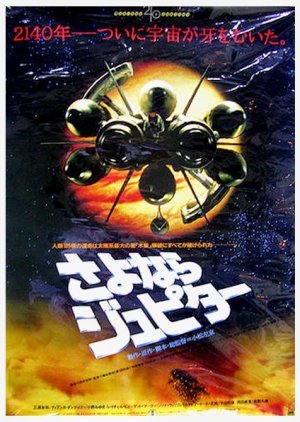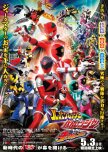While extracting water from the Martian polar ice caps, ancient carvings are uncovered describing an alien spacecraft crashing into Jupiter, postponing plans to turn Jupiter into a second Sun. Edit Translation
- English
- magyar / magyar nyelv
- dansk
- Norsk
- Native Title: さよならジュピタ
- Also Known As: Bye Bye Jupiter ,
- Screenwriter: Nagahara Hideichi
- Genres: Sci-Fi
Cast & Credits
- Miura Tomokazu Main Role
- Okada MasumiMuhammad MansourSupport Role
- Morishige Hisaya Support Role
- Andrew Hughes[Senator Shadillic]Guest Role
Reviews

Revolution in the field of space archaeology!
Sayonara Jupiter has been my white whale for so long but finally, after so long, today is the day I have finally managed to sit down and watch it and boy is it so much better than its reputation suggests. I'll admit it's no masterpiece with a fair amount that doesn't quite work and is almost comparable to being a retread of Gorath but on a solar level. I will say that Bye-Bye Jupiter as it's also known, as a whole, it's greater than the sum of its parts.In the 22nd century, scientists from an energy-depleted Earth research new fuel sources in the far corners of the solar system, where they discover an ancient alien race from Jupiter as well as the emergence of an apocalyptically dangerous black hole.
When Star Wars was released in Japan in 1978, the science fiction boom of Japan well and truly kicked into overdrive. Both Toho and Toei tried to capitalise on the success of this reignited love of science fiction with both producing their own takes on Star Wars, The War in Space and Message from Space respectively. Prior to the production of The War in Space, Toho offered a contract to author Sakyo Komatsu to write a science fiction film. Komatsu had long desired to make a film comparable to 2001: A Space Odyssey, taking further inspiration from NASA's Voyager mission to Jupiter and the outer planets. As such this is the only work of Komatsu that had been designed and destined to be a film from the very beginning.
One could argue that Toho didn't know when to tell Komatsu to stop because the film is brimming with so many ideas that it would be enough for a whole trilogy centred around the concepts presented. Just to rattle off the basic bits you have the solarization project, Jupiter Church unrest, an alien race on Jupiter, a black hole approaching, a dolphin named Jupiter and a battle with a shark. It can sometimes feel overwhelming with the amount of stuff you're expected to follow but while the film may lack a distinct focus to it, Komatsu populates the film with his typical philosophical dialogue and discussion. Being over 2-hours long, it lends the film a sense of epic scale to its storytelling but could have used a lot more focus on one distinct idea to truly rise above what it encapsulates.
The film had originally supposed to have been helmed by Submersion of Japan's director, Shirō Moritani but he tragically died the same year due to stomach cancer. Final directorial duties on the film are divided, with Komatsu being credited as the main director but is more often than not thought to have only been the major creative influence on the project and main duties fell to The Return of Godzilla director Koji Hashimoto in the only other director's credit of his career. While ultimately I feel The Return of Godzilla is the more well-rounded film, Hashimoto doesn't half deliver a visual tour-da-force and possibly one of the best-looking films in Toho's tokusatsu library with Bye-Bye Jupiter.
It manifestly demonstrates the same subtle and unpretentious filmmaking style that was also present in The Return of Godzilla. His beautifully coordinated images, combined with some excellent sound engineering and special effects, turn a third-act shootout into one of the film's most immersive sequences. Better still, we have a thematic element that he would later use brilliantly in The Return of Godzilla: a sense of unity. Even at a basic level, Hashimoto remained a humanist to the end.
Major major kudos need to be thrown towards the goat that is Koichi Kawakita in his first major special effects director credit. The film already benefitted from the work of Koji Hashimoto but add in Kawakita's special effects and the film becomes a whole other breed. It's, for a lack of a better word, simply stunning. They are jaw-dropping even by today's standards of miniature effects, the spaceships are rich with detail and, filmed at the proper camera speed, effectively convey a sense of mass and scale as they drift through the universe. Background mattes and optical effects for the stars and planets similarly look wonderful; so good, in fact, that in the few odd moments where the film decides to use a stock image of the real outer space, Kawakita's manufactured effects, oddly enough, stick out as more dynamic. Let's also not forget about the viscous, unrelenting gusts of different-coloured smoke utilized for a scene where a small ship pilots through the storm clouds of Jupiter.
My other major gripe with the film is the characters who are very thin ranging from robotic to mediocre. There are a few performances in there that try and sell the material but being this is a film predominantly shot by a Japanese crew and nearly half the film is also in English it makes some of the already poor actings in some scenes all the worse. It's a crying shame given this was also Akihiko Hirata's final film before his untimely death, Hirata is definitely one of the better players in the film but is given barely anything to do. Tomokazu Miura as Eiji Honda and Miyuki Ono as Anita give okay performances, they are both clearly trying but there seems to be a lack of understanding with some of the material present.
The other element of the film I quickly want to address is the musical score by Kentaro Haneda, who also composed the utterly divine music to one of Komatsu's other film adaptations, Virus. It's a marvellous creation, alternating between softness and sweeping awe in the background. The songs are just as beautiful but are probably more well-known nowadays for being shamelessly stolen by Hideaki Anno for use in Eva 3.0+1.0.
Overall, Bye-Bye Jupiter while being a relative mess is a thoroughly engaging, visual extravagance with one too many things going on and overly long in places. One or two revisions and this could have been a bonified Toho classic.
Was this review helpful to you?
Recommendations
There have been no recommendations submitted. Be the first and add one.
































